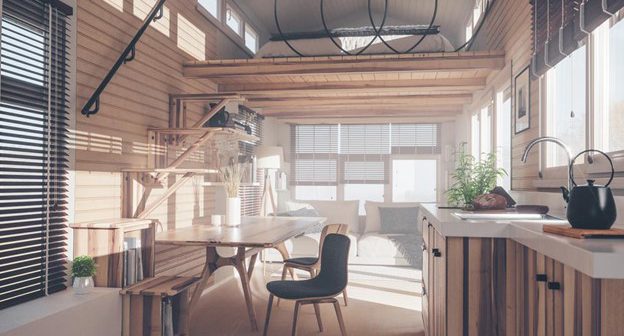Downsizing from a family home is a significant decision that involves emotional, practical, and financial considerations.
Whether driven by a desire for a simpler lifestyle, lower expenses, or a smaller environmental footprint, moving to a smaller space can offer many benefits. One popular option in recent years has been transitioning to a tiny home.
This blog will explore the key factors to consider when downsizing your family home, including the option of moving to a tiny home.
Assess Your Reasons for Downsizing
Before making the decision to downsize, it is crucial to evaluate your emotional readiness. Moving from a home where many memories were created can be challenging. Are you ready to part with sentimental items that may not fit in a smaller space? How do you feel about leaving a home where you raised your family?
Also, consider whether you are excited about the idea of starting fresh in a new, smaller space. Reflecting on these questions can help determine if you are emotionally prepared for such a change.
Financial considerations are equally important when contemplating downsizing. Moving to a smaller home can lead to significant financial benefits, such as reduced mortgage payments, lower utility bills, and decreased maintenance costs. It’s essential to evaluate the potential savings and how the sale of your current home might impact your finances.
Also, consider any costs associated with purchasing and moving into a smaller home or tiny home. Understanding the financial implications will help you make a well-informed decision.
Evaluate Your Space Needs
Assessing your current and future space needs is a critical step in the downsizing process. Consider how much space you realistically need for daily living. Do you require extra rooms for hobbies, guests, or a home office? Think about how your space needs might change as you age. This evaluation will help you determine the appropriate size for your new home.
Storage solutions become particularly important when moving to a smaller home or tiny home. Consider what items are essential and which can be donated or sold. Maximizing storage in a smaller space requires creativity. Look for furniture with built-in storage, use vertical space effectively, and consider nearby storage facilities for items you can’t part with but don’t need daily. Efficient storage solutions will help make your smaller home feel more spacious and organized.
Tiny Home Considerations
Living in a tiny home requires a significant lifestyle adjustment. Are you comfortable with minimalism and living with fewer possessions? How do you feel about the limited space for entertaining guests?
Tiny homes come with unique challenges, such as managing small spaces and potential zoning issues. It’s important to thoroughly research tiny homes for sale and understand the challenges before making a commitment.
Legal and zoning regulations are critical factors to consider when thinking about a tiny home. Research local regulations to determine if there are restrictions on where tiny homes can be located. Understand the zoning laws in your area regarding tiny homes and any legal hurdles to placing a tiny home on your property or buying land for one. Being well-informed about these regulations will help avoid potential issues down the road.
Practical Steps for Downsizing
Decluttering is a crucial step in the downsizing process. Start early to give yourself plenty of time to sort through belongings. Focus on one room at a time to avoid feeling overwhelmed. Use the “four-box method” by labeling boxes as keep, donate, sell, and trash. This methodical approach will help you efficiently decide what to keep and what to part with.
Once you’ve decluttered, consider how to handle items you won’t be taking with you. Holding a garage sale or selling items online can provide some extra cash. Donating gently used items to charities or giving them to family and friends can be a fulfilling way to part with possessions. For items that cannot be sold or donated, ensure they are recycled or disposed of responsibly.
Finding the right smaller home is the next step. Consider the location in terms of proximity to family, friends, healthcare, and amenities. Think about the type of community you prefer, whether it’s a bustling urban area or a quiet rural setting. Additionally, consider the accessibility of the home and whether it is suitable for ageing in place. These factors will help ensure that your new home meets your needs and preferences.
Benefits of Downsizing
One of the main benefits of downsizing is financial savings. Smaller homes typically come with reduced mortgage or rent payments and lower utility bills due to less space to heat, cool, and light. Maintenance and repair costs also tend to be lower, freeing up more of your budget for other priorities.
A smaller home often means a simpler, more manageable lifestyle. With less space to clean and maintain, you can spend more time enjoying activities and hobbies. Downsizing encourages a focus on experiences rather than accumulating possessions, contributing to a more fulfilling and stress-free life.
Downsizing, particularly to a tiny home, can have a positive environmental impact. Reduced energy consumption and a lower carbon footprint are significant benefits. Tiny homes often promote sustainable living practices, such as using solar panels and rainwater collection systems, making them an eco-friendly choice.
Challenges to Consider
Letting go of a family home can be emotionally challenging. To ease this transition, take photos and videos to preserve memories. Hosting a farewell gathering can be a meaningful way to celebrate the time spent in the home. Focusing on the positive aspects of moving to a new space can also help manage the emotional difficulty.
Living in a smaller space requires adjustment. Investing in multi-functional furniture and getting creative with storage solutions can make the transition smoother. Maintaining a clutter-free environment will help maximize the feeling of space and make your new home more comfortable.
It’s natural to have second thoughts about such a significant change. To mitigate potential regrets, thoroughly research and plan before making the move. Talking to others who have downsized or live in tiny homes can provide valuable insights and help set realistic expectations. Give yourself time to adjust and adapt to the new living situation, and remember that it’s okay to have mixed feelings.
Final Thoughts
Downsizing your family home is a major decision that requires careful consideration of emotional, practical, and financial factors.
Moving to a smaller home or even a tiny home can offer numerous benefits, including financial savings, simplified living, and a reduced environmental footprint.
By assessing your needs, planning thoughtfully, and embracing the change, you can make a successful transition to a smaller, more manageable living space.





This post is very helpful to me because it has a lot of information. I always like to read posts with good content, and I found that in your post. Papa’s freezeria